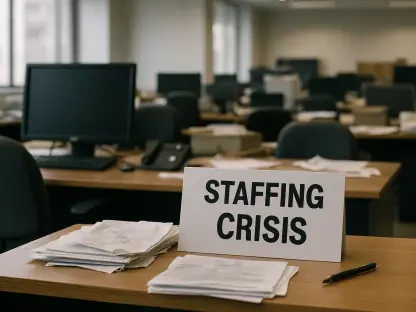The troubling workplace culture within Fargo Cass Public Health (FCPH) has come under scrutiny following the release of dozens of exit interviews obtained through a Freedom of Information Act request. These interviews reveal a pattern of severe criticisms directed at the department’s leadership and the environment they have fostered. Former employees describe the workplace culture as toxic, stressful, and unhealthy, with issues such as poor management, lack of communication, and instances of intimidation and dishonesty being prevalent.
High Employee Turnover
Increasing Turnover Rates
Over the past three years, FCPH has experienced a noticeable increase in employee turnover. In 2024 alone, 52 employees left the department, compared to 37 in 2023 and 48 in 2022. This upward trend is particularly pronounced within the Harm Reduction programs, where 26 employees exited in 2024, a significant jump from 21 in 2023 and 18 in 2022. Given that the Harm Reduction division comprises only 44 positions, this turnover means that over half of its staff departed in 2024, highlighting a critical level of instability.
Such high turnover rates in these vital programs inevitably cast a shadow on the effectiveness and stability of FCPH’s operations. The departure of more than half of the staff in a single year raises serious concerns about the underlying causes and the potential impact on the delivery and consistency of public health services. Former employees have directly pointed to the toxic work environment as a significant factor contributing to this mass exodus, calling into question the ability of current leadership to maintain a stable and supportive workforce.
Impact on Harm Reduction Programs
The alarming turnover rate within the Harm Reduction programs suggests significant instability within a critical division of FCPH. As a result, the consistency and quality of services provided by these programs could be severely impacted. Harm reduction services are essential for managing public health crises, particularly those related to substance abuse, and the loss of experienced staff may further strain these efforts. Former employees indicate that a toxic work environment, marked by poor management and lack of support, is driving many to seek employment elsewhere, threatening the continuity of critical health initiatives.
The departure of a substantial portion of staff within the Harm Reduction division also indicates deeper systemic issues. It raises questions about the department’s commitment to fostering a supportive and healthy workplace. Considering the challenging nature of work within harm reduction, where employees frequently deal with high-stress situations, a stable and positive work environment is crucial. The significant turnover undermines the department’s ability to deliver on its public health mission effectively, potentially leading to gaps in service and affecting community health outcomes.
Workplace Culture Criticisms
Employee Dissatisfaction
Exit interviews illuminate deep dissatisfaction with the workplace culture at FCPH. Many former employees describe an environment fraught with stress, intimidation, dishonesty, and a pervasive lack of communication. For example, a medical technologist in 2024 expressed severe frustration with the toxic workplace culture, citing significant issues concerning communication and management’s dishonesty and manipulation. This individual also highlighted personal attacks and gossip from the management, further illustrating a hostile work environment that discourages honest communication and professional growth.
Such testimonials underscore the pervasive issues within the FCPH’s environment. The accounts detail a pattern where poor management practices and interpersonal conflicts greatly affect employee morale and productivity. The lack of effective communication and the presence of dishonest managerial behavior undermine the integrity and trust required for a functional workplace. These negative factors do not only impact those directly subjected to them but also create a ripple effect, influencing the overall workplace atmosphere and the collective efficacy of the entire team.
Lack of Teamwork and Support
Beyond individual accounts of dissatisfaction, the exit interviews also reveal broader systemic issues, such as the lack of teamwork and support across departments. For instance, a registered nurse in 2024 highlighted ongoing tensions between various divisions, pointing to a severe lack of collaboration and teamwork. This nurse warned that unless significant changes are made, continued turnover could be expected, painting a bleak picture of the future work environment at FCPH.
In addition, a Community Health Educator in 2023 noted that an unsupportive supervisor played a crucial role in their decision to leave. The reported environment was described as challenging and intimidating, further eroding the collaborative spirit essential to public health work. These observations indicate that FCPH suffers from deep-rooted issues in leadership and organizational support, suggesting that the problems are not isolated but endemic to the department. The magnitude of these issues necessitates a comprehensive review and restructuring to foster a more supportive and cohesive working atmosphere.
Management Responses
City Officials’ Perspective
City officials have responded to the turnover and culture issues by framing the problem within the broader context of industry trends. Beth Wiegman, Fargo Assistant Director of Human Resources, noted that the high turnover rate at FCPH is consistent with changes in workforce dynamics and the competitive healthcare job market. She emphasized the fierce competition with larger private healthcare facilities, which often offer more attractive employment packages, making it difficult for public health departments like FCPH to retain talent.
Wiegman also brought attention to specific situations that may have contributed to the turnover rates, including the transition of Correctional Health Nurses’ employment from the city to the county and budget cuts in 2024. These factors, according to city officials, account for some of the turnover figures and are reflective of external pressures rather than purely internal management failures. This perspective sheds light on the complexity of the issue, suggesting that while internal culture and leadership are critical, external industry trends also play a significant role.
Addressing Exit Interviews
Wiegman emphasized that the city takes exit interviews seriously, but the responses from these interviews need to be addressed on an individual basis. She underlined that implementing a one-size-fits-all solution isn’t feasible, as each exit interview provides subjective insights from single employees. Instead, each case is handled with an appropriate and bespoke action plan, aiming to address specific issues raised by departing employees. This approach highlights the city’s acknowledgment of the problem but also the challenges in developing effective solutions.
This nuanced approach suggests that while management recognizes the severity of the issues raised, there is a perceived challenge in deploying uniform solutions due to the unique nature of each situation. The individual handling of cases underscores the complexity of addressing systemic issues within the department. Ensuring these personalized plans are effective in fostering a healthier, more supportive work environment remains a significant challenge that requires ongoing attention and adjustment from the leadership.
Leadership Changes and Future Plans
New Leadership Initiatives
The recent leadership change at FCPH has brought renewed focus on addressing the workplace culture issues. Jennifer Faul, who assumed the role of Director in the summer of 2024, has made it a priority to improve intra-department communication. Faul aims to break down silos that have formed within the six divisions of FCPH, fostering a more collaborative and supportive work environment. These efforts are seen as crucial steps toward mitigating the toxic workplace culture that has led to high staff turnover and dissatisfaction.
Faul’s approach suggests a shift towards greater transparency and cooperation within the department. By prioritizing communication and collaboration, she seeks to create a more cohesive and resilient workforce. However, Faul and Wiegman declined to comment on specific cases, indicating a focus on systemic solutions rather than addressing individual grievances publicly. This strategic pivot underlines the importance of leadership in setting the tone for workplace culture and the need for ongoing commitment to these initiatives to see effective change.
Challenges and Improvements
Faul noted that efforts have already been made to enhance communication across divisions, suggesting an improved workplace culture as a result. These initial steps indicate a positive trend, but consistent implementation of these changes remains challenging. Both Faul and Wiegman reiterated the difficulty in maintaining a consistently positive workplace culture, especially in a high-pressure environment such as public health. The complexity of public health dynamics, compounded by external pressures like budget constraints and workforce competition, adds layers of difficulty to fostering lasting cultural improvements.
Despite these challenges, the leadership changes and renewed focus on communication and collaboration offer a glimmer of hope for the future. Effective, sustained efforts are critical to reversing the negative trends and building a supportive environment conducive to attracting and retaining dedicated public health professionals. Continuous evaluation and adaptation of strategies based on employee feedback will be essential in this ongoing effort to improve workplace culture at FCPH.
Broader Implications
Industry Trends and Workforce Dynamics
City officials have noted broader industry trends and workforce dynamics as contributing factors to the high turnover rates at FCPH. The competitive healthcare job market and evolving workforce expectations are external pressures that exacerbate internal issues. Larger private healthcare institutions often have more resources to offer better salaries and benefits, making it challenging for public health departments to compete. This perspective suggests that the challenges FCPH faces are part of a larger trend affecting the healthcare industry nationwide, rather than problems unique to one department.
Understanding these broader dynamics is critical for contextualizing the issues at FCPH. While internal management and workplace culture play significant roles, the healthcare industry’s competitive nature and constant evolution also impact employee retention and satisfaction. Addressing the high turnover and toxic work culture at FCPH thus requires a multifaceted approach that considers both internal reforms and strategies to navigate external industry pressures.
Addressing Systemic Issues
The Fargo Cass Public Health (FCPH) department has recently faced criticism due to its troubling workplace culture. This scrutiny comes after dozens of exit interviews were released, obtained through a Freedom of Information Act request. These interviews highlight a consistent pattern of severe criticisms aimed at the department’s leadership and the working environment they have created. Former employees describe the culture at FCPH as toxic, stressful, and unhealthy. Key issues mentioned include poor management practices, a significant lack of effective communication, and instances of intimidation and dishonesty within the department. According to these exit interviews, the problematic culture at FCPH has led to a high level of dissatisfaction among employees, contributing to an unhealthy work atmosphere and the departure of several staff members. The feedback from former employees indicates that substantial changes are necessary to address these deep-rooted issues and to create a healthier and more productive work environment for current and future employees.









